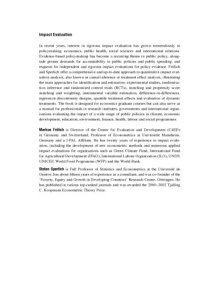"In recent years, interest in rigorous impact evaluation has grown tremendously in policy-making, economics, public health, social sciences and international relations. Evidence-based policy-making has become a recurring theme in public policy, alongside greater demands for accountability in public policies and public spending, and requests for independent and rigorous impact evaluations for policy evidence.
Frölich and Sperlich offer a comprehensive and up-to-date approach to quantitative impact evaluation analysis, also known as causal inference or treatment effect analysis, illustrating the main approaches for identification and estimation: experimental studies, randomization inference and randomized control trials (RCTs), matching and propensity score matching and weighting, instrumental variable estimation, differences-in-differences, regression discontinuity designs, quantile treatment effects and evaluation of dynamic treatments. The book is designed for economics graduate courses but can also serve as a manual for professionals in research institutes, governments, and international organizations, evaluating the impact of a wide range of public policies in health, environment, transport and economic development"--"This book on advanced econometrics is intended to familiarise the reader with technical developments in the area of econometric which is known under the label treatment e ect estimation, or impact or policy evaluation. In this book we have tried to combine the intuitive reasoning for identi cation and estimation with the econometric and statistical rigorousness. This holds especially for the complete list of stochastic assumptions and their implications in practise. Moreover, for both, identi cation and estimation we focus mostly on nonparametric methods (i.e. our methods are not based on speci c pre-speci ed models or functional forms) in order to provide methods that are quite generally valid. Graphs and a number examples of evaluation studies are applied to explain how sources of exogenous variation can be explored for disentangling causality from correlation"--
Read more... 